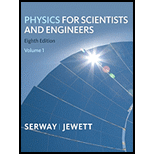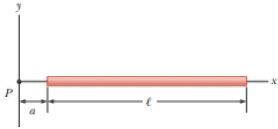
Concept explainers
A uniformly charged filament lies along the x axis between x = a = 1.00 m and x = a + ℓ = 3.00 m as shown in Figure P25.66. The total charge on the filament is 1.60 nC. Calculate successive approximations for the electric potential at the origin by modeling the filament as (a) a single charged particle at x = 2.00 m, (b) two 0.800-nC charged particles at x = 1.5 m and x = 2.5 m, and (c) four 0.400-nC charged particles at x = 1.25 m, x = 1.75 m, x = 2.25 m, and x = 2.75 m. (d) Explain how the results compare with the potential given by the exact expression

(a)
The electric potential due to single charge particle.
Answer to Problem 25.66AP
The electric potential due to single charge particle is
Explanation of Solution
Given info: The total charge on the filament is
Formula to calculate the electric potential due to point change is,
Here,
Substitute
Conclusion:
Therefore, the electric potential due to single charge particle is
(b)
The electric potential due to two charged particles.
Answer to Problem 25.66AP
The electric potential due to two charged particles is
Explanation of Solution
Given info: The charge on two particles is
Formula to calculate the total electric potential tow charge particles is,
Here,
Substitute
Conclusion:
Therefore, the electric potential due to two charged particles is
(c)
The electric potential due to four charged particles.
Answer to Problem 25.66AP
The electric potential due to four charged particles is
Explanation of Solution
Given info: The charge on four particles is
Formula to calculate the total electric potential tow charge particles is,
Here,
Substitute
Conclusion:
Therefore, the electric potential due to four charged particles is
(d)
The comparison between the electric potential due to charged filament and the calculated value of electric potential in part (a), part (b) and part (c).
Answer to Problem 25.66AP
The calculated value of electric potential due to charged filament is
Explanation of Solution
The total charge on the filament is
The given expression of the electric potential is,
Here,
Substitute
The electric potential due to charged filament is
Conclusion:
Therefore, the calculated value of electric potential is
Want to see more full solutions like this?
Chapter 25 Solutions
Physics for Scientists and Engineers, Volume 1, Chapters 1-22
- suggest a reason ultrasound cleaning is better than cleaning by hand?arrow_forwardCheckpoint 4 The figure shows four orientations of an electric di- pole in an external electric field. Rank the orienta- tions according to (a) the magnitude of the torque on the dipole and (b) the potential energy of the di- pole, greatest first. (1) (2) E (4)arrow_forwardWhat is integrated science. What is fractional distillation What is simple distillationarrow_forward
- 19:39 · C Chegg 1 69% ✓ The compound beam is fixed at Ę and supported by rollers at A and B. There are pins at C and D. Take F=1700 lb. (Figure 1) Figure 800 lb ||-5- F 600 lb بتا D E C BO 10 ft 5 ft 4 ft-—— 6 ft — 5 ft- Solved Part A The compound beam is fixed at E and... Hình ảnh có thể có bản quyền. Tìm hiểu thêm Problem A-12 % Chia sẻ kip 800 lb Truy cập ) D Lưu of C 600 lb |-sa+ 10ft 5ft 4ft6ft D E 5 ft- Trying Cheaa Những kết quả này có hữu ích không? There are pins at C and D To F-1200 Egue!) Chegg Solved The compound b... Có Không ☑ ||| Chegg 10 וחarrow_forwardNo chatgpt pls will upvotearrow_forwardNo chatgpt pls will upvotearrow_forward
- No chatgpt pls will upvotearrow_forwardair is pushed steadily though a forced air pipe at a steady speed of 4.0 m/s. the pipe measures 56 cm by 22 cm. how fast will air move though a narrower portion of the pipe that is also rectangular and measures 32 cm by 22 cmarrow_forwardNo chatgpt pls will upvotearrow_forward
- 13.87 ... Interplanetary Navigation. The most efficient way to send a spacecraft from the earth to another planet is by using a Hohmann transfer orbit (Fig. P13.87). If the orbits of the departure and destination planets are circular, the Hohmann transfer orbit is an elliptical orbit whose perihelion and aphelion are tangent to the orbits of the two planets. The rockets are fired briefly at the depar- ture planet to put the spacecraft into the transfer orbit; the spacecraft then coasts until it reaches the destination planet. The rockets are then fired again to put the spacecraft into the same orbit about the sun as the destination planet. (a) For a flight from earth to Mars, in what direction must the rockets be fired at the earth and at Mars: in the direction of motion, or opposite the direction of motion? What about for a flight from Mars to the earth? (b) How long does a one- way trip from the the earth to Mars take, between the firings of the rockets? (c) To reach Mars from the…arrow_forwardNo chatgpt pls will upvotearrow_forwarda cubic foot of argon at 20 degrees celsius is isentropically compressed from 1 atm to 425 KPa. What is the new temperature and density?arrow_forward
 Physics for Scientists and Engineers: Foundations...PhysicsISBN:9781133939146Author:Katz, Debora M.Publisher:Cengage Learning
Physics for Scientists and Engineers: Foundations...PhysicsISBN:9781133939146Author:Katz, Debora M.Publisher:Cengage Learning Physics for Scientists and Engineers with Modern ...PhysicsISBN:9781337553292Author:Raymond A. Serway, John W. JewettPublisher:Cengage Learning
Physics for Scientists and Engineers with Modern ...PhysicsISBN:9781337553292Author:Raymond A. Serway, John W. JewettPublisher:Cengage Learning Principles of Physics: A Calculus-Based TextPhysicsISBN:9781133104261Author:Raymond A. Serway, John W. JewettPublisher:Cengage Learning
Principles of Physics: A Calculus-Based TextPhysicsISBN:9781133104261Author:Raymond A. Serway, John W. JewettPublisher:Cengage Learning Physics for Scientists and Engineers, Technology ...PhysicsISBN:9781305116399Author:Raymond A. Serway, John W. JewettPublisher:Cengage Learning
Physics for Scientists and Engineers, Technology ...PhysicsISBN:9781305116399Author:Raymond A. Serway, John W. JewettPublisher:Cengage Learning Physics for Scientists and EngineersPhysicsISBN:9781337553278Author:Raymond A. Serway, John W. JewettPublisher:Cengage Learning
Physics for Scientists and EngineersPhysicsISBN:9781337553278Author:Raymond A. Serway, John W. JewettPublisher:Cengage Learning College PhysicsPhysicsISBN:9781305952300Author:Raymond A. Serway, Chris VuillePublisher:Cengage Learning
College PhysicsPhysicsISBN:9781305952300Author:Raymond A. Serway, Chris VuillePublisher:Cengage Learning





